Abstract
OBJECTIVE: The purpose of this randomized, prospective clinical trial was to determine whether hypothermia during resuscitation is protective or harmful to critically injured trauma patients. SUMMARY BACKGROUND DATA: Hypothermia has both protective and harmful clinical effects. Retrospective studies show higher mortality in patients with hypothermia; however, hypothermia is more common in more severely injured patients, which makes it difficult to determine whether hypothermia contributes to mortality independently of injury severity. There are no randomized, prospective treatment studies to assess hypothermia's impact as an independent variable. METHODS: Fifty-seven hypothermic (T < or = 34.5 C), critically injured patients requiring a pulmonary artery catheter were randomized to a rapid rewarming protocol using continuous arteriovenous rewarming (CAVR) or to a standard rewarming (SR) control group. The primary outcome of interest was first 24-hour blood product and fluid resuscitation requirements. Other comparative analyses included coagulation assays, hemodynamic and oxygen transport measurements, length of stay, and mortality. RESULTS: The two groups were well matched for demographic and injury severity characteristics. CAVR rewarmed significantly faster than did SR (p < 0.01), producing two groups with different amounts of hypothermia exposure. The patients who underwent CAVR required less fluid during resuscitation to the same hemodynamic goals (24,702 mL vs. 32,540 mL, p = 0.05) and were significantly more likely to rewarm (p = 0.002). Only 2 (7%) of 29 patients who underwent CAVR failed to warm to 36 C and both died, whereas 12 (43%) of 28 patients who underwent SR failed to reach 36 C, and all 12 died. Patients who underwent CAVR had significantly less early mortality (p = 0.047). CONCLUSION: Hypothermia increases fluid requirements and independently increases acute mortality after major trauma.
Full text
PDF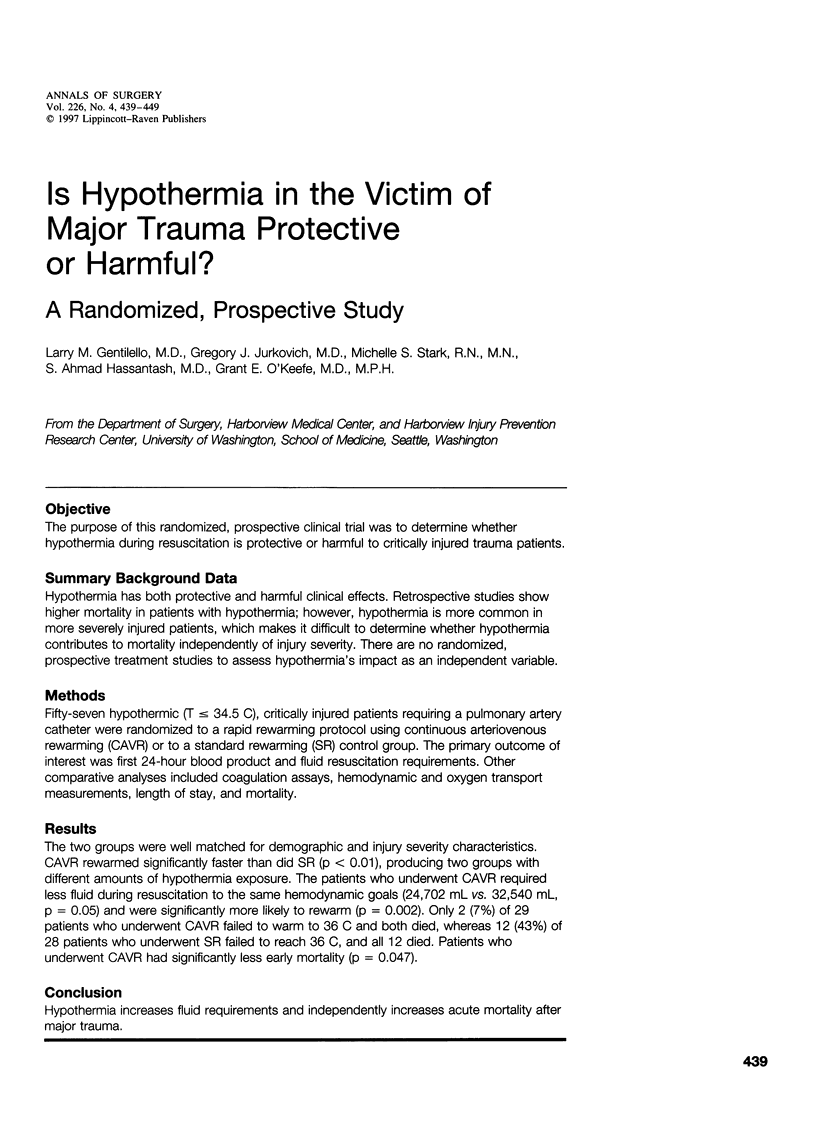
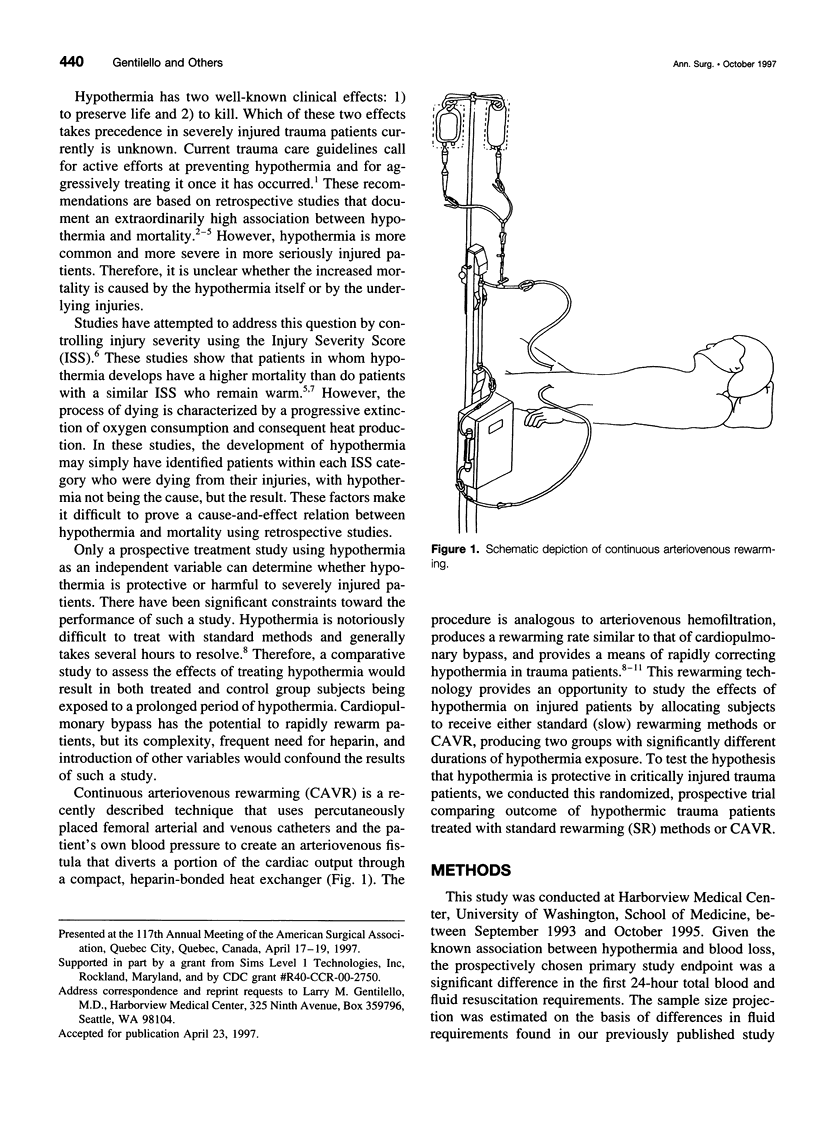

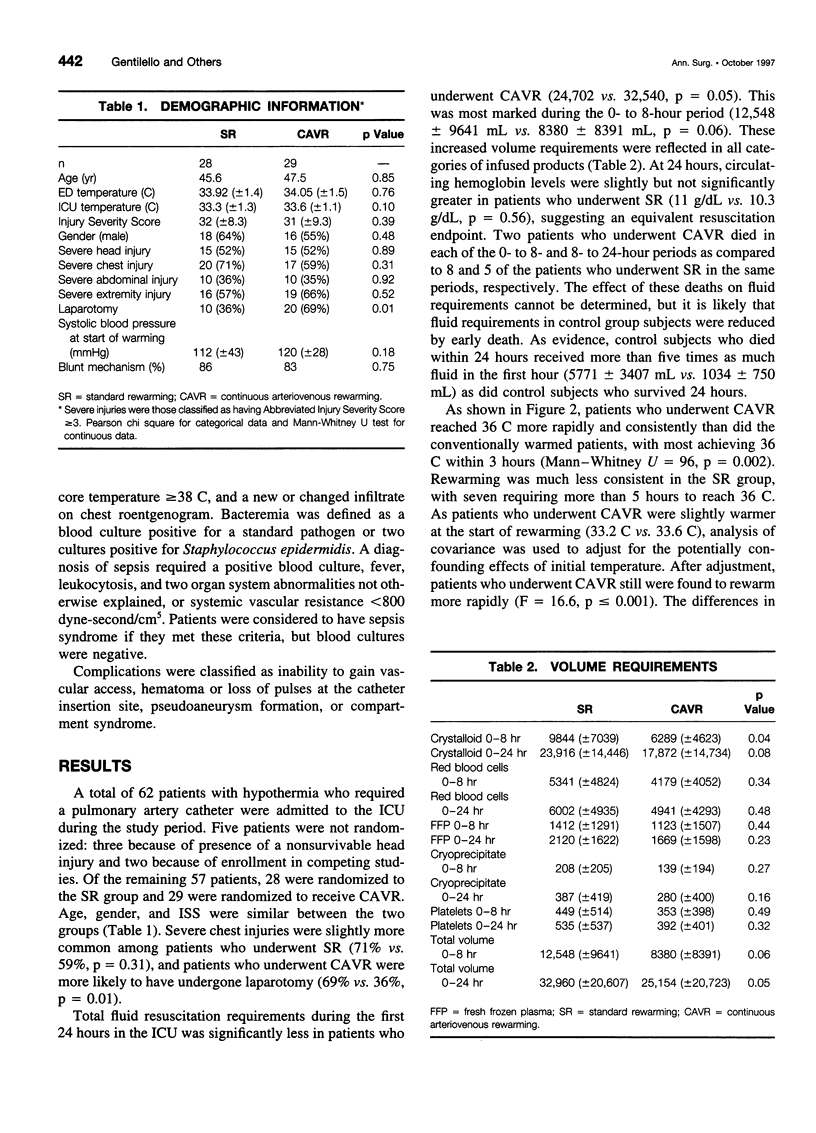



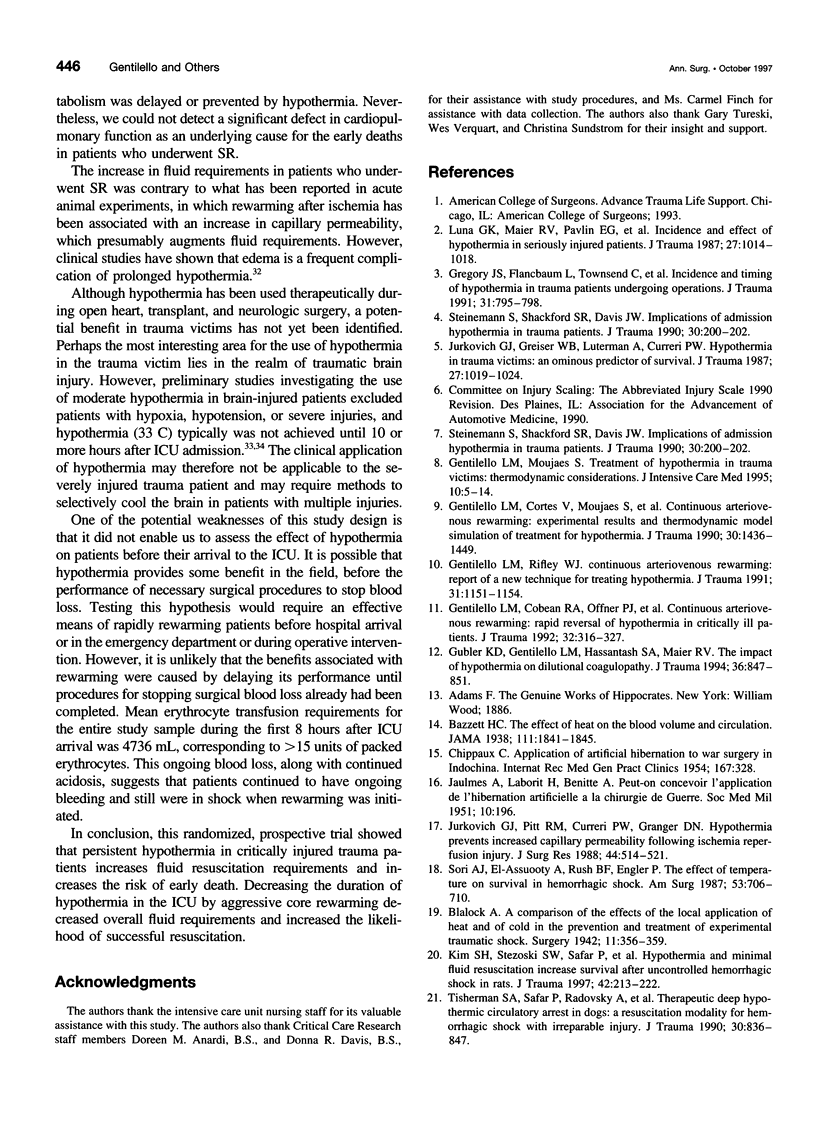
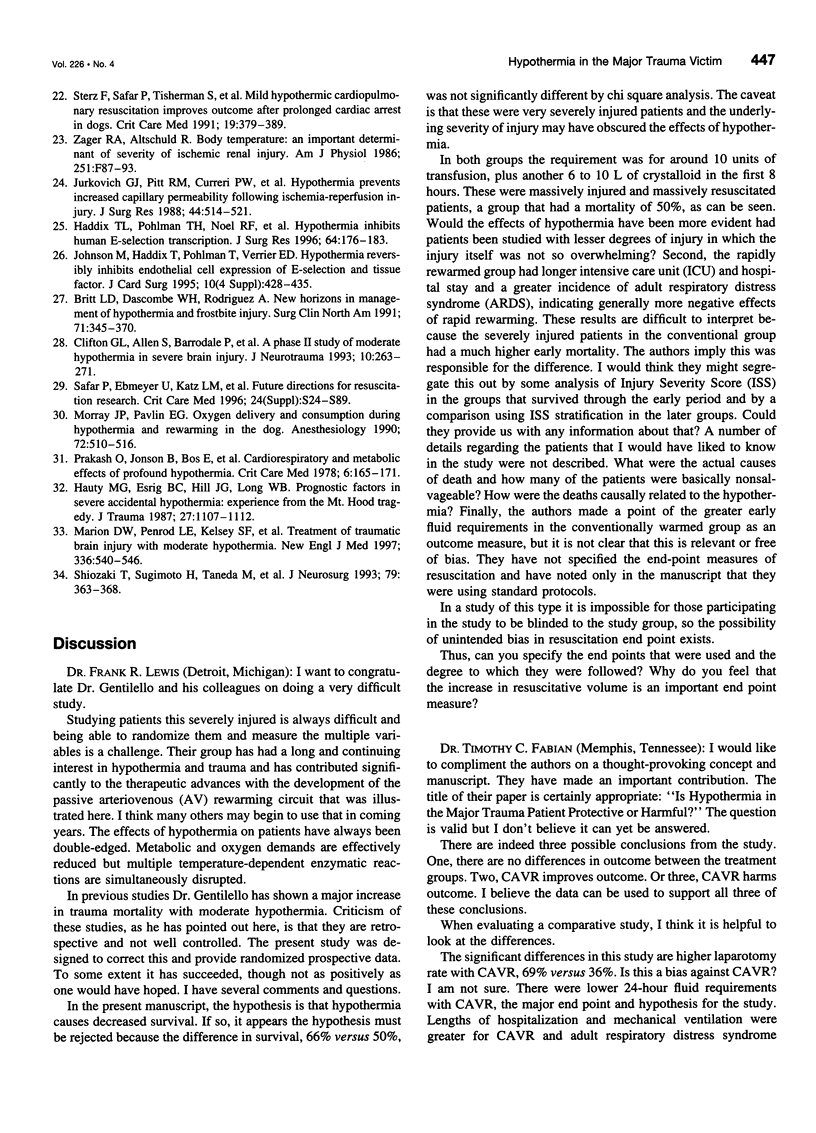
Selected References
These references are in PubMed. This may not be the complete list of references from this article.
- Bellamy R., Safar P., Tisherman S. A., Basford R., Bruttig S. P., Capone A., Dubick M. A., Ernster L., Hattler B. G., Jr, Hochachka P. Suspended animation for delayed resuscitation. Crit Care Med. 1996 Feb;24(2 Suppl):S24–S47. [PubMed] [Google Scholar]
- Britt L. D., Dascombe W. H., Rodriguez A. New horizons in management of hypothermia and frostbite injury. Surg Clin North Am. 1991 Apr;71(2):345–370. doi: 10.1016/s0039-6109(16)45384-3. [DOI] [PubMed] [Google Scholar]
- CHIPPAUX C. Application of artificial hibernation to war surgery in Indochina. Int Rec Med Gen Pract Clin. 1954 Jun;167(6):328–332. [PubMed] [Google Scholar]
- Clifton G. L., Allen S., Barrodale P., Plenger P., Berry J., Koch S., Fletcher J., Hayes R. L., Choi S. C. A phase II study of moderate hypothermia in severe brain injury. J Neurotrauma. 1993 Fall;10(3):263–273. doi: 10.1089/neu.1993.10.263. [DOI] [PubMed] [Google Scholar]
- Gentilello L. M., Cobean R. A., Offner P. J., Soderberg R. W., Jurkovich G. J. Continuous arteriovenous rewarming: rapid reversal of hypothermia in critically ill patients. J Trauma. 1992 Mar;32(3):316–327. doi: 10.1097/00005373-199203000-00009. [DOI] [PubMed] [Google Scholar]
- Gentilello L. M., Cortes V., Moujaes S., Viamonte M., Malinin T. L., Ho C. H., Gomez G. A. Continuous arteriovenous rewarming: experimental results and thermodynamic model simulation of treatment for hypothermia. J Trauma. 1990 Dec;30(12):1436–1449. [PubMed] [Google Scholar]
- Gentilello L. M., Moujaes S. Treatment of hypothermia in trauma victims: thermodynamic considerations. J Intensive Care Med. 1995 Jan-Feb;10(1):5–14. doi: 10.1177/088506669501000103. [DOI] [PubMed] [Google Scholar]
- Gentilello L. M., Rifley W. J. Continuous arteriovenous rewarming: report of a new technique for treating hypothermia. J Trauma. 1991 Aug;31(8):1151–1154. [PubMed] [Google Scholar]
- Gregory J. S., Flancbaum L., Townsend M. C., Cloutier C. T., Jonasson O. Incidence and timing of hypothermia in trauma patients undergoing operations. J Trauma. 1991 Jun;31(6):795–800. doi: 10.1097/00005373-199106000-00009. [DOI] [PubMed] [Google Scholar]
- Gubler K. D., Gentilello L. M., Hassantash S. A., Maier R. V. The impact of hypothermia on dilutional coagulopathy. J Trauma. 1994 Jun;36(6):847–851. doi: 10.1097/00005373-199406000-00015. [DOI] [PubMed] [Google Scholar]
- Haddix T. L., Pohlman T. H., Noel R. F., Sato T. T., Boyle E. M., Jr, Verrier E. D. Hypothermia inhibits human E-selectin transcription. J Surg Res. 1996 Aug;64(2):176–183. doi: 10.1006/jsre.1996.0325. [DOI] [PubMed] [Google Scholar]
- Hauty M. G., Esrig B. C., Hill J. G., Long W. B. Prognostic factors in severe accidental hypothermia: experience from the Mt. Hood tragedy. J Trauma. 1987 Oct;27(10):1107–1112. [PubMed] [Google Scholar]
- Johnson M., Haddix T., Pohlman T., Verrier E. D. Hypothermia reversibly inhibits endothelial cell expression of E-selectin and tissue factor. J Card Surg. 1995 Jul;10(4 Suppl):428–435. doi: 10.1111/j.1540-8191.1995.tb00673.x. [DOI] [PubMed] [Google Scholar]
- Jurkovich G. J., Greiser W. B., Luterman A., Curreri P. W. Hypothermia in trauma victims: an ominous predictor of survival. J Trauma. 1987 Sep;27(9):1019–1024. [PubMed] [Google Scholar]
- Jurkovich G. J., Pitt R. M., Curreri P. W., Granger D. N. Hypothermia prevents increased capillary permeability following ischemia-reperfusion injury. J Surg Res. 1988 May;44(5):514–521. doi: 10.1016/0022-4804(88)90156-4. [DOI] [PubMed] [Google Scholar]
- Jurkovich G. J., Pitt R. M., Curreri P. W., Granger D. N. Hypothermia prevents increased capillary permeability following ischemia-reperfusion injury. J Surg Res. 1988 May;44(5):514–521. doi: 10.1016/0022-4804(88)90156-4. [DOI] [PubMed] [Google Scholar]
- Kim S. H., Stezoski S. W., Safar P., Capone A., Tisherman S. Hypothermia and minimal fluid resuscitation increase survival after uncontrolled hemorrhagic shock in rats. J Trauma. 1997 Feb;42(2):213–222. doi: 10.1097/00005373-199702000-00006. [DOI] [PubMed] [Google Scholar]
- Luna G. K., Maier R. V., Pavlin E. G., Anardi D., Copass M. K., Oreskovich M. R. Incidence and effect of hypothermia in seriously injured patients. J Trauma. 1987 Sep;27(9):1014–1018. doi: 10.1097/00005373-198709000-00010. [DOI] [PubMed] [Google Scholar]
- Marion D. W., Penrod L. E., Kelsey S. F., Obrist W. D., Kochanek P. M., Palmer A. M., Wisniewski S. R., DeKosky S. T. Treatment of traumatic brain injury with moderate hypothermia. N Engl J Med. 1997 Feb 20;336(8):540–546. doi: 10.1056/NEJM199702203360803. [DOI] [PubMed] [Google Scholar]
- Morray J. P., Pavlin E. G. Oxygen delivery and consumption during hypothermia and rewarming in the dog. Anesthesiology. 1990 Mar;72(3):510–516. doi: 10.1097/00000542-199003000-00020. [DOI] [PubMed] [Google Scholar]
- Prakash O., Jonson B., Bos E., Meij S., Hugenholtz P. G., Hekman W. Cardiorespiratory and metabolic effects of profound hypothermia. Crit Care Med. 1978 May-Jun;6(3):165–171. doi: 10.1097/00003246-197805000-00009. [DOI] [PubMed] [Google Scholar]
- Shiozaki T., Sugimoto H., Taneda M., Yoshida H., Iwai A., Yoshioka T., Sugimoto T. Effect of mild hypothermia on uncontrollable intracranial hypertension after severe head injury. J Neurosurg. 1993 Sep;79(3):363–368. doi: 10.3171/jns.1993.79.3.0363. [DOI] [PubMed] [Google Scholar]
- Sori A. J., el-Assuooty A., Rush B. F., Jr, Engler P. The effect of temperature on survival in hemorrhagic shock. Am Surg. 1987 Dec;53(12):706–710. [PubMed] [Google Scholar]
- Steinemann S., Shackford S. R., Davis J. W. Implications of admission hypothermia in trauma patients. J Trauma. 1990 Feb;30(2):200–202. doi: 10.1097/00005373-199002000-00011. [DOI] [PubMed] [Google Scholar]
- Steinemann S., Shackford S. R., Davis J. W. Implications of admission hypothermia in trauma patients. J Trauma. 1990 Feb;30(2):200–202. doi: 10.1097/00005373-199002000-00011. [DOI] [PubMed] [Google Scholar]
- Sterz F., Safar P., Tisherman S., Radovsky A., Kuboyama K., Oku K. Mild hypothermic cardiopulmonary resuscitation improves outcome after prolonged cardiac arrest in dogs. Crit Care Med. 1991 Mar;19(3):379–389. doi: 10.1097/00003246-199103000-00017. [DOI] [PubMed] [Google Scholar]
- Tisherman S. A., Safar P., Radovsky A., Peitzman A., Sterz F., Kuboyama K. Therapeutic deep hypothermic circulatory arrest in dogs: a resuscitation modality for hemorrhagic shock with 'irreparable' injury. J Trauma. 1990 Jul;30(7):836–847. [PubMed] [Google Scholar]
- Zager R. A., Altschuld R. Body temperature: an important determinant of severity of ischemic renal injury. Am J Physiol. 1986 Jul;251(1 Pt 2):F87–F93. doi: 10.1152/ajprenal.1986.251.1.F87. [DOI] [PubMed] [Google Scholar]


